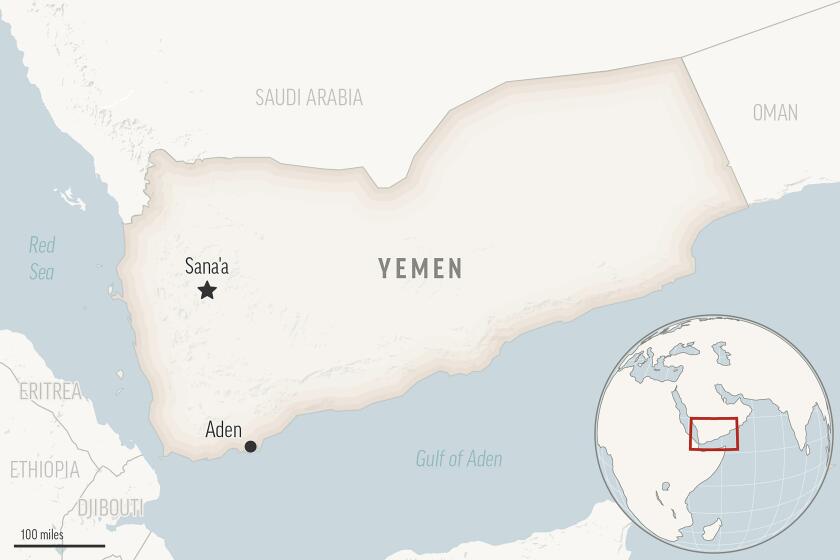Huge Tanker Firm Files for Bankruptcy : Sanko Becomes Largest Corporate Failure in Postwar Japan
- Share via
TOKYO — Sanko Steamship Co., the world’s largest operator of oil tankers, filed Tuesday for protection from its creditors and reorganization under Japan’s bankruptcy laws.
It was the largest corporate failure in postwar Japan and sent ripples through Japan’s political hierarchy.
State Minister Toshio Komoto, Sanko’s 74-year-old founder and former president, resigned from the Japanese Cabinet, thus leading some observers to question Sanko’s chances for more government assistance. Komoto, who owns 3.3% of Sanko’s stock and is considered to be its controlling shareholder, has been mentioned in the past as a possible candidate for prime minister.
Sanko had been surviving its annual losses of more than $200 million largely on the basis of a bail-out negotiated under Komoto’s wing and granted by the company’s creditors. But last week, Sanko’s three main banks turned down requests for new loans, touching off a crisis that led to the filing Tuesday morning at a court in Amagasaki, where the company is headquartered.
Three Sanko-affiliated companies also sought the Japanese court’s protection. Even so, the steamship company’s failure is expected to have only limited effects on the Japanese economy; Sanko directly employs about 2,500 people.
Precedent Set in Japan
But the filing itself set a precedent in Japan, where conventional economic wisdom holds that large-scale bankruptcies must be avoided at all costs to uphold stability at home and Japan’s reputation abroad. Of the 20,800 Japanese companies that went bankrupt in 1984, most were tiny. If a big company does get into trouble, government and creditor help is usually speedy and sufficient to prevent filing.
Sanko’s problems also illustrate the continuing surfeit of ills in oil-related industries. Of Sanko’s fleet of 250 vessels, half are oil or gas tankers.
In addition to the major oil companies, oil service firms, engineering concerns and shipbuilders and operators have fallen victim to depressed oil prices and the inventory glut.
Under Japanese law, the court will now determine whether the company can be salvaged, or “rehabilitated.” If so, its assets would be frozen, an operating agent appointed and a restructuring plan devised under the supervision of the court.
Previously, the largest bankruptcy in postwar Japan was by Eidai Co., which applied for restructuring in 1978 with debts of about $750 million. By contrast, Sanko’s bank debt is estimated at $2 billion, and Japan’s financial press has calculated Sanko’s debts to trading and chartering companies at another $2 billion.
Employees at offices of Sanko Kisen, the company’s United States arm, declined to comment on how much the company might owe North American creditors. But a representative of a Seattle stevedoring company that supplies workers for Sanko operations said payment negotiations were delicate and “we’re all scared.”
Sanko ships call at every major West Coast port, loading and discharging break bulk (packaged or bundled products such as grains, steel, coil, lumber and logs) and tanked petroleum products. Asa Shigley, who runs Sanko Kisen’s Seattle office, the only West Coast office it maintains, said the company temporarily was halting its West Coast activities, waiting for instructions from Tokyo after the filing.
But Cascade Shipping, the agent for most of Sanko’s West Coast shipping activities, said Sanko ships were moving in and out of Long Beach and Los Angeles ports as usual.
A Sanko oil tanker left Tuesday morning, said Bing de la Vega, Cascade’s Los Angeles branch manager, and another one was ready to call at Long Beach for fueling on its way back to Japan with a load of cargo.
Fleet 20% of Market
Although only a small portion of West Coast port activity, Sanko’s fleet accounted for about 20% of the Japanese shipping market. Most of Sanko’s ships are owned by foreign companies and chartered long term to Sanko. This allowed cut-rate financing and hiring of foreign crew members, whose wages are lower than those made by Japanese seamen.
Tankers and break bulk operations--mainstays of Sanko’s shipping--are two of the industry’s niches that are suffering the most, said William D. Tichy, a shipping analyst at Dean Witter in San Francisco. Even in 1984, an outstanding year for containerized cargo shipments, he said, tankers were in trouble, and three or four companies pulled out of the highly competitive Pacific Basin routes.
In the early 1970s, Sanko began a daring program to acquire large numbers of brand new supertankers. But following the 1973 oil shock, the market for the huge ships collapsed and the company was saddled with costly idle capacity.
The Japanese shipping industry in general began feeling squeezed in the 1970s and was classified as a declining industry by the Japanese government and made eligible for various aid programs to ease the descent.
Restructuring Designed
Under the patronage of Komoto, who heads one of the major factions of the ruling Liberal Democratic Party, a three-year restructuring plan was designed for Sanko to acquire new bulk cargo carriers and unload some of its supertankers. But that plan stalled earlier this year and Sanko began looking to sell its supertankers and cut back its new purchases.
Sanko’s three primary lenders, frustrated by the lack of explicit guarantees from the government, withdrew from negotiations for new loans and virtually forced the bankruptcy filing.
The news touched off a selling panic of Sanko’s shares, leading the Tokyo Stock Exchange to suspend dealings in them.
Hours before the company filed, Komoto volunteered to resign his Cabinet post. However, he did not quit his seat in the Diet, or Japanese Parliament, and said he will stay on as head of his faction.
More to Read
Sign up for Essential California
The most important California stories and recommendations in your inbox every morning.
You may occasionally receive promotional content from the Los Angeles Times.













